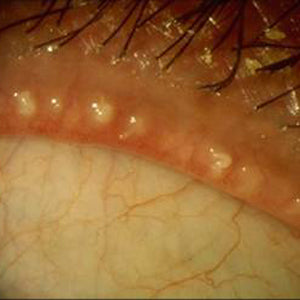The safe & effective solution for cleaning red, itchy, crusty, inflamed eyes
Primocyn Eye Cleanser is the safe & effective solution to good eyelid & eyelash hygiene.
- hypochlorous acid (HOCl)
- Steroid-Free
- Antibiotic-Free
- Non-Irritating
- Non-Cytotoxic
- Non-Sensitizing
- Requires No Special Handling

For the safe and effective removal of encrustation and debris.
Primocyn Eye Cleanser contains hypochlorous acid (HOCl) which has been proven to be safe in over five million users to date. HOCl at the concentration levels found in Primocyn Eye Cleanser can be used safely around eyes, ears, nose, and mouth.
What is hypochlorous acid (HOCl)?
HOCl is a compound that is produced naturally by the immune system, particularly neutrophils, to eradicate microorganisms.1
Benefits of HOCl
Stabilized hypochlorous acid (HOCl) helps reduce itch, inflammation and pain. It is also a powerful antimicrobial that kills skin pathogens associated with blepharitis, MGD, demodex and dry eye.
Who will HOCl help and what are the benefits?
HOCl has several specific properties that are beneficial for various skin conditions including those around eyelids and eyelashes. These include:
- Potent antimicrobial
- Reduction of pain and itch
- Reduction of inflammation
- Breaks down biofilm formed by S. aureus
 Blepharitis
Blepharitis MGD
MGD Demodex
Demodex Dry Eye
Dry EyeNot all HOCl solutions are created equal

The positive effects of HOCl on the human body, both inside and out, have been studied and Recognized by medical scientists worldwide for over 100 years.
Today, Hypochlorous acid is bottled in a stabilized form so that you have a weapon to use against The countless environmental aggressors that threaten the health of your skin.
Don’t be fooled by others who claim to have superior HOCl solutions. Primocyn’s original HOCl formulas have been continuously improved over time and have set the standard of quality, stability and efficacy.

Potent Antimicrobial
Time Kill Study: In vitro HOCl eradication of pathogens
- Greater than 99% reduction in killing 23 different microorganisms, including S. aureus and S. aureus-MRSA
- Time to kill 30 seconds
| Name of Organism | Log Reduction | Log Reduction | Percent Reduction |
|---|---|---|---|
| Acinetobacter baumannii | 7.0488 | 30 seconds | 99.9999% |
| Bacteroides fragilis | 3.3565 | 30 seconds | 99.9560% |
| Candida albicans | 6.4699 | 30 seconds | 99.9999% |
| Corynebacterium diphtherieae | 5.2778 | 30 seconds | 99.9995% |
| Clostridium difficile (spores) | 4.6085 | 30 seconds | 99.9975% |
| Enterobacter aerogenes | 6.7200 | 30 seconds | 99.9999% |
| Enterococcus faecalis-VRE MDR | 5.6085 | 30 seconds | 99.9998% |
| Escherichia coli | 6.5272 | 30 seconds | 99.9999% |
| Haemophilus influenzae | 5.4107 | 30 seconds | 99.9996% |
| Klebsiella oxytoca | 6.7810 | 30 seconds | 99.9999% |
| Klebsiella pneumoniae ozaenae |
6.8086 | 30 seconds | 99.9999% |
| Malassezia furfur | 5.3953 | 30 seconds | 99.9996% |
| Micrococcus yunnanensis | 5.6137 | 30 seconds | 99.9998% |
| Propionibacterium acnes | 5.2967 | 30 seconds | 99.9995% |
| Proteus mirabilis | 6.7477 | 30 seconds | 99.9999% |
| Pseudomonas aeruginosa | 6.5867 | 30 seconds | 99.9999% |
| Serratia marcescens | 6.5811 | 30 seconds | 99.9999% |
| Staphylococcus aureus-MRSA | 6.7032 | 30 seconds | 99.9999% |
| Staphylococcus aureus | 6.5008 | 30 seconds | 99.9999% |
| Staphylococcus pyogenes |
6.4214 | 30 seconds | 99.9999% |
| Trichophyton mentagrophytes |
4.6752 | 30 seconds | 99.9979% |
| Trichophyton rubrum |
2.5234 | 30 seconds | 99.7004% |
| Vibrio vulnificus |
5.1888 | 30 seconds | 99.9994% |
Reduction in Pain and Itch
Case Study #1
Open-Label Study
Study Design- Open-label, single-arm study over 7 days
- HOCl rapidly reduces pruritus in mild-to-moderate atopic dermatitis (AD)
- 50% of patients experienced a reduction by Day 1
- 85% of patients experienced a reduction by Day 3

Case Study #2
Randomized, Blinded, Controlled Study
Study Design- 72-hour study
- Treated group (n=19): HOCl BID
- Untreated group (n=10): No treatment
- Mean pruritus VAS scores between treated and untreated group were significantly different between baseline and 72 hours post application

Anti-Inflammatory Activity
HOCl for Inhibition of Mast Cell Degranulation
- Prevents allergen- and calcium-induced mast cell degranulation for up to 8 hours after a single exposure in-vitro
- Reduces wound inflammation that inhibits healing
- Stabilizes the mast cell membrane to inhibit the cell machinery for granule secretion, while not altering the signal transduction pathways or calcium mobilization
- Inhibits degranulation stimulated by antigen or calcium ionophore

*A23187 + PMA is a calcium ionophore; †b-hexosaminidase is a marker of IgE-antigen-induced mast cell degranulation.
Breaks Down Bacterial Biofilm
Biofilm formation is recognized as a serious problem in chronic wound infections. Biofilm characteristics include
- Complex structure of microorganisms that generate a protective shell, allowing bacteria to collect and proliferate
- Most microorganisms that form biofilms found growing in microbial infection
- Adheres to chronic wounds, makes phagocytosis difficult, and increases resistance to antibiotics
- Inhibits degranulation stimulated by antigen or calcium ionophore
HOCl has antibiofilm activity and actively breaks down biofilm and kills microorganisms within the biofilm.

Corresponding microbicidal activity: 1/64 and lower dilutions of HOCl demonstrated zero colony-forming units of S. aureus
Increases Oxygenation

- Provides higher levels of oxygen at a wound site after application
- Elevated blood and oxygen flow increases wound-healing nutrients
Assists Wound Healing
Wound healing involves a complex sequence of events. Fibroblasts are the primary synthetic cells in the repair process of most structural proteins used during tissue reconstruction.
At lower concentrations, the percentage of fibroblast migration exceeded that of the control at 24 hours.

Although fibroblasts have a critical role in wound healing, their proliferation highly relates to keratinocyte proliferation and mediators secreted from keratinocytes.
Similar results were obtained for keratinocyte migration: At lower HOCl concentrations, the percentage of keratinocyte migration exceeded that of the control at 24 hours
